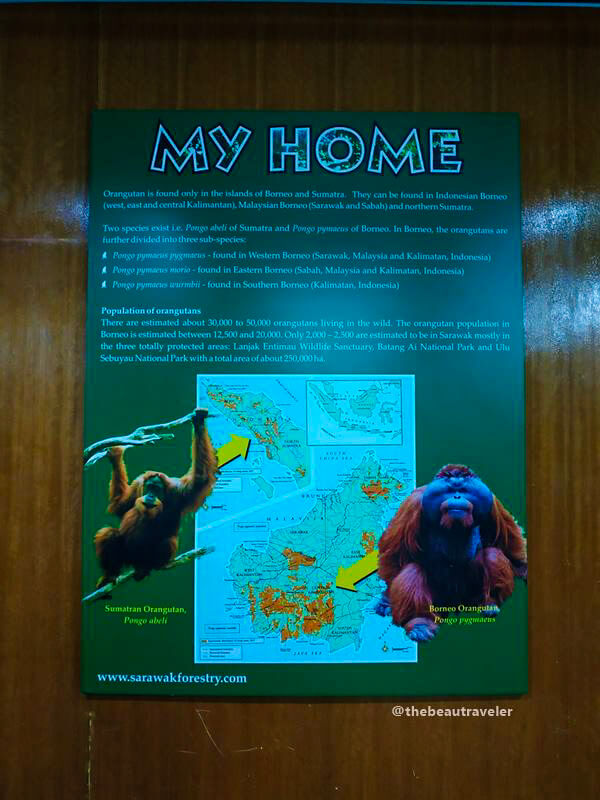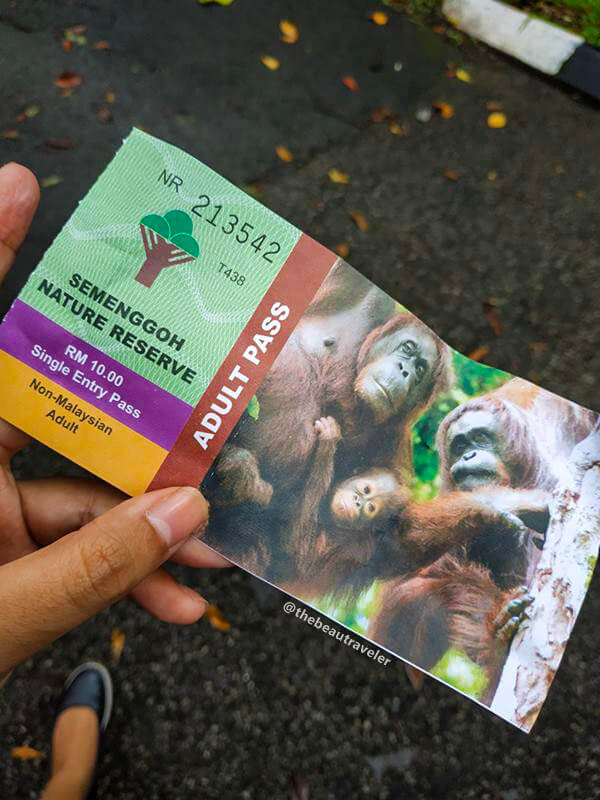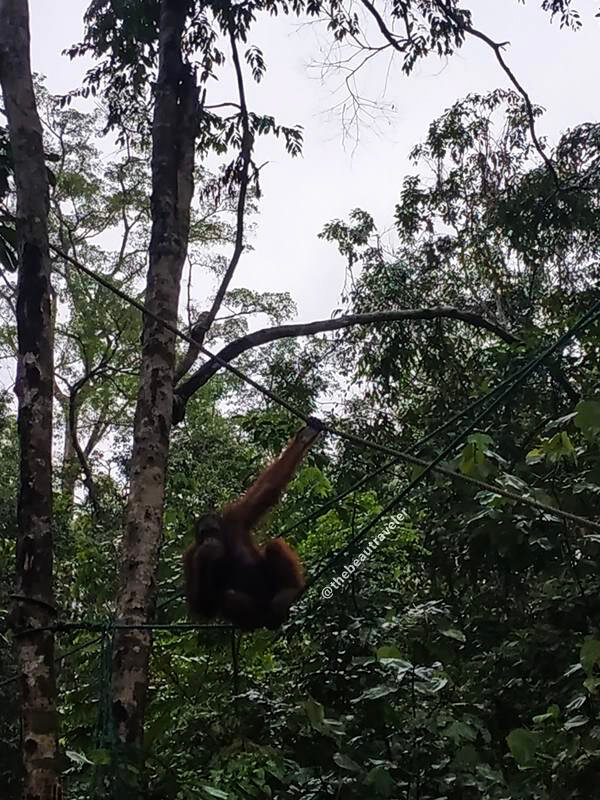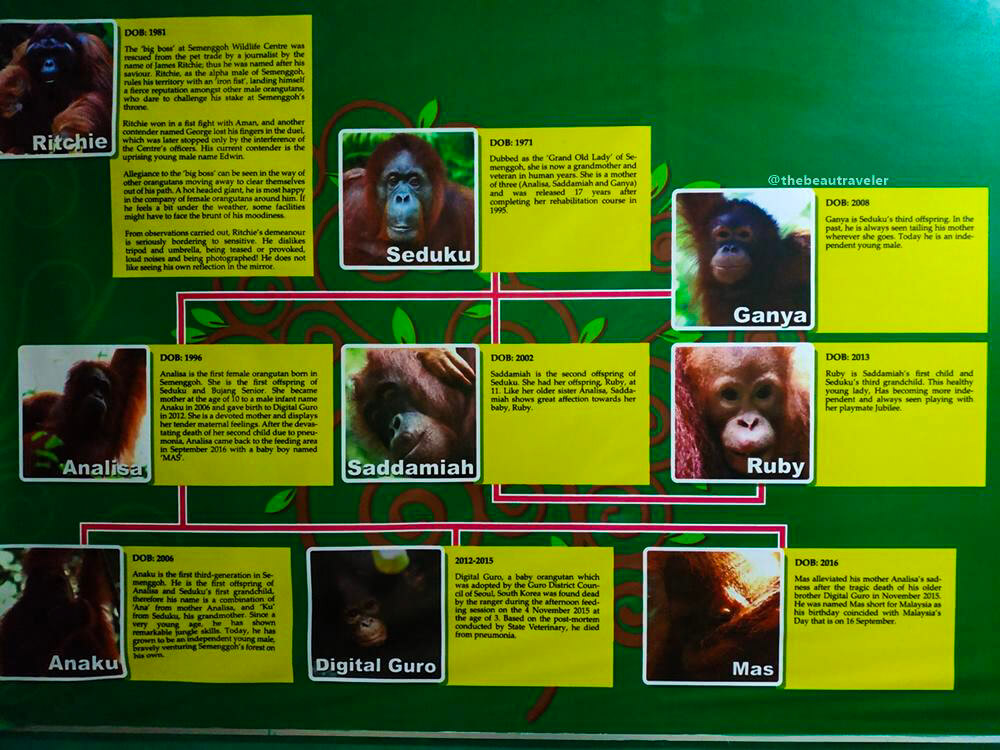If there's anything you should prioritizing while visiting Borneo, I think it's gonna be to visit orangutan sanctuaries. There are a few places where you can see orangutans in their natural habitat on the island. In Indonesia, the largest one is in Tanjung Puting National Park in Central Kalimantan. You can also go to Sepilok in Sabah, but Semenggoh Nature Reserve is one you can visit in Sarawak, East Malaysia.
I got a chance to visit Semenggoh from Kuching as a part of my Borneo trip, so in this post I'm going to share everything you need to know about visiting an orangutan sanctuary in Sarawak. From how to get there, and what you need to expect from this wildlife experience in Borneo!
Orangutans in Borneo
As I mentioned earlier, there are two places in the world where we could still see orangutans in their natural habitat. It is in either Borneo or Sumatra. And the significant difference between the Bornean orangutan from the Sumatra one is that they have a larger body than their Sumatran counterpart.
Orangutans are considered to be one of the world's smartest primates. And Semenggoh, the natural conservation that I visited earlier when I was in Kuching, it used to be the home of Delima. In case you're not familiar with the name, I think Delima used to be one of the most popular orangutans in the world. She had got these distinguished short bangs that made her the covergirl for various publications.
Before I decided to go to Semenggoh myself, I didn't know this until I saw the pictures and family tree of orangutans there. And I could remember that I might have seen Delima's picture somewhere. Delima has passed away in 2013, but then her children are still around the jungle.

Semenggoh Nature Reserve, Borneo
Unlike the regular zoo, the objective of Semenggoh is to reintroduce orangutans back into the wild. The visitors are welcomed to watch them during the feeding time in the morning or in the evening.
But then again, since they get reintroduced to the wild, visitors are not guaranteed to be able to see them up close. Some of them even chose to be totally wild back in the jungle.
Like even though the rangers schedule feeding time in daily basis, they don't always come to the rehabilitation center. Hence, it's not guaranteed for you to see one even though you come during the feeding time.
Apart from orangutans, Semenggoh is also the home for some crocodiles and hornbills.
Update: The bus to Semenggoh is no longer operating. So, you might as well take the consideration to rent a car or use Grab to get there from the city center. Alternatively, you can also book a Semenggoh Nature Reserve tour from Kuching here.
How to Get to Semenggoh Nature Reserve
Semenggoh Nature Reserve is located around 45 minutes from Kuching city center. There are some options that you could choose to get to Semenggoh.
And if you're keen to join a tour to Semenggoh, you could actually find some travel agency that offers the service around the city center. In my case, my accommodation Woodpecker Lodge actually offers the tour to Semenggoh for 70 MYR (around $17 USD) with the entry fee included. However, they need minimum of 2 pax for the tour.
So, since I traveled solo, I had no choice to go there by myself. I could either take the bus or rent the car, and I chose the latter for my convenience.
As for me, I got to know Gabriel when I ordered Grab from Kuching cat museum to get back to my hotel. And I decided to ask him whether he could take me to Semenggoh. He agreed, and he checked Grab app first to offer me the offline fee and that time, I only had to pay for 60 MYR (around $15 USD) for the car. But with that amount of money, he'd take me to Semenggoh and wait until I finish. And he even took me to a really nice ice cream parlor after that.
You can contact Gabriel by e-mail at gabraphael1993@gmail.com
But no worries, I've done some research for you who are keen to take the bus to Semenggoh, and as it turned out you could take the bus number 6 from Jalan Masjid station. It will stop in front of the entrance, and you just need to walk a bit to get to the feeding station.

Entrance Fee to Semenggoh Nature Reserve
If there's anything I've learned about traveling with Asian face in Malaysia, it's to not speak too much that they might as well give me the local entry ticket. 😛
So, most of the places wouldn't even check your ID to prove whether you're Malaysian or foreigner. And most of the times, they couldn't tell that I'm actually Indonesian until I speak with my stupid Indonesian accent. HAHA.
Anyway, I bought two tickets to Semenggoh, one for me and one for Gabriel. As I bought the ticket for the foreigner, it only costs me 10 MYR (around $2.5 USD). For local Malaysian visitors, that would be half the price.
Visiting Hours at Semenggoh Nature Reserve

Gabriel took his guests so many times to Semenggoh that he knows by heart the schedule of opening hours at the nature reserve. Semenggoh Nature Reserve opens during the feeding time, other than that visitors are not allowed to come around the feeding platform area.
Feeding time in the morning starts at 8 AM up to 10 AM. After 10 AM, the feeding station will be closed for public but you can stay at the entrance hall reading some information about the orangutans. That includes the family tree and some background story about each orangutan.

If you think you're not gonna make it in the morning, you can also visit Semenggoh in the evening as the feeding time starts again at 3 PM to 5 PM.
I went to Semenggoh for the morning feeding time. As I mentioned several times, I couldn't expect many orangutans coming to the feeding station. When I went there, I could only see one orangutan coming for the feeding time.
It was Ganya, a 10-year-old orangutan who according to the family tree and information that I read, used to be that one kid who would cling to his mother in the past. Now, I could tell he's grown up and independent.
Is It Worth to Visit Semenggoh Nature Reserve?
The main reason why I made my way to Semenggoh is actually because I've read through the internet and most people would recommend Sepilok to see orangutans in Sabah.
However, when I discussed with Suzie, she told me that Sepilok is located around Sandakan, which is close to the Philippines and popular for some pirates kidnapping tourists for ransom. Some countries even give some travel warning to their citizens to get there, so I was a bit hesitant to go to Semenggoh after she told me that information.
When I decided to go there, I really just hoped that at least one orangutan would come up so I could see them in the wild. Unlike those orangutans I've seen in the zoo. And I was quite entertained just to see Ganya go back and forth for some bananas.

If you asked me whether it's worth to visit Semenggoh, then I think if you really, really want to see orangutans in the wild and one comes down to the feeding station, then it's gonna be your lucky day.
But I understand that I've read some reviews about those visitors who didn't see anyone since no orangutans come during the feeding time. So, really… It all depends on your luck. But then again, you'll never know if you don't come. Better come than sorry, no?! 😉
Besides, if you're interested to adopt an orangutan through donation, you can. You can come to the reception desk to register yourself, or you can also visit their website to sign up.
So, have you seen orangutans in the wild? Is your experience as good as mine in Semenggoh? Or even better? Tell me your story in the comment section, and cheerio! 😀











Comments are closed.